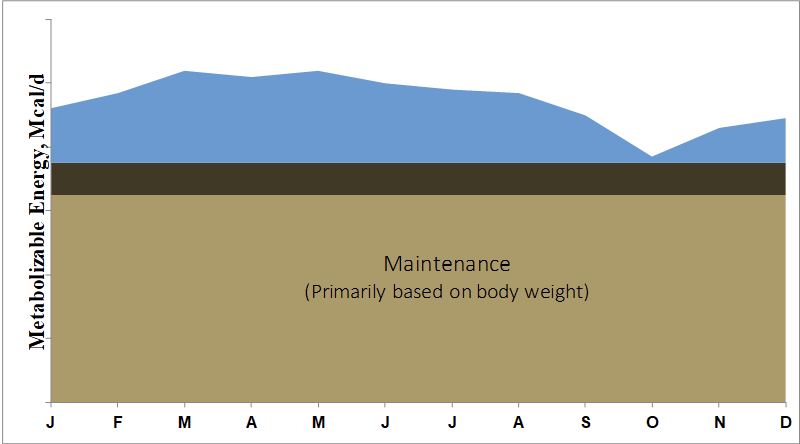
By Chris Cassady, Ph.D.
We have a symbiotic relationship with grazing cattle, in which they convert cellulose and other inedible fibrous material into a wholesome protein product for human consumption. There are many types of production systems, cattle breed types and available resources across the domestic cow-calf sector, but the basic nutritional demands are somewhat standard across the board. In lay terms, regardless of genetics or environment, there is seldom a time throughout the production year where the cow cannot meet her nutritional needs with acceptable quality grass, harvested or available forage. However, the last 60 days prior to calving and immediately after parturition, cattle nutritional demands increase dramatically (Table 1.). These changes in basal metabolic requirements are a direct result of 1. Rapid fetal growth and the cow preparing herself for the stress of calving, 2. Initiating the lactation process and 3. The return to a fertile state for the subsequent breeding season.
Table 1. Annual Energy Requirement of a Spring-Calving Beef Cow

It’s clear that spring-calving herds are currently managing cows at the peak of their nutritional demands. Producers also have groups of first timers that are still growing and haven’t reached their mature size and weight. Optimizing nutrition at this critical wintertime point is imperative for maximizing production efficiency. Are your females nutritionally prepared?
With many producers already into the heart of calving and others with due dates approaching, what is actually happening biologically to the females at this stage? If she is a heifer, a good portion of her nutrition is being partitioned toward growth. However, all females are directing a large portion of their dietary nutrition toward fetal growth and preparation of parturition. During the first and second trimesters, fetal life functions such as vital organs and skeletal-muscular system are developed. The third trimester results in nearly 75% of the fetal growth during the entire pregnancy and prepares the calf for extra-uterine life. If you bred your cow or heifer on time, she’s currently in the third trimester or has recently calved, so it’s important to know that the energy/protein demand for her calf should be accounted for. Additionally, the cow needs a bioavailable Vitamin A and E supply along with trace minerals such as copper, zinc and selenium to support a healthy, vigorous calf.
Some producers are reluctant to supplement their cows at this timepoint, fearing the dogma of increased birthweights and subsequent dystocia. No doubt, calf birth weight is influenced by the maternal plane of nutrition, and a summary of research by Bellows (1993) indicates this trend (Table 2.).
Table 2. Effect of low or high gestation feeding level on calving and subsequent reproduction.

Range Beef Cow Symposium XIII, 1993, pp. 175-189.
However, this increase in birth weight does not necessarily correlate to more incidence of dystocia. It’s important to remember that birth weight is only one component of calving ease. Outside of abnormal presentations (i.e. breech), the cow’s energy status and glycogenic reserves are critical for her to physically push that calf through the birth canal. We’ve all given assistance (especially to a heifer) at calving time, and it’s exhausting on us. Think about the energy just spent by the cow! In fact, calves that are born from mothers on a high pre-calving plane of nutrition were up and nursing their dams faster than those born from dams with a low plane of pre-calving nutrition (Lardy and Stolenow, 2001; Krokev and Cummins, 1979). Bottom line, thin cows with no energy stores may in fact have a tougher time calving, regardless of calf size.
Speaking of nursing, lactation’s the final step in this whole transition process, and it’s an important one. Nutritional requirements continue to rise for nearly 60 days post-partum, where nearly two-thirds of the total milk will be produced by the dam. Energy, protein, vitamins and minerals are vital for quality milk and early calf performance. If nutritional demands for lactation cannot be met, the cow will start to mobilize her own body reserves to support lactation, resulting in loss of BCS, metabolic disorder and immune system depression. Since we don’t really know the milking potential of each cow until she’s in production, it’s important to pay attention to cows that appear to be sick or losing weight, because females who are losing weight during the breeding season have decreased conception rates.
This concept comes full circle, because we need a cow to calve unassisted, wean off a heavy calf, and breed back on time to maintain an economically viable production cycle. Don’t overfeed your females but understand now is not the time to cut corners on your cowherd nutrition. Producers should best utilize their forages with Amaferm®, a research-proven prebiotic that promotes intake, digestibility and absorption of nutrients. Better utilization of feeds results in cows having adequate energy to calve, begin lactation and colostrum production, yet maintain BCS and breed back on time in the spring. BioZyme® products like the VitaFerm® Concept•Aid® Mineral Tub contain Amaferm as well as highly bioavailable organic trace minerals so you can trust each female to support herself and her newborn calf. VitaFerm Concept•Aid contains organic copper, zinc and manganese to ensure maximum bioavailability of nutrients to the animal, as well as high levels of vitamin E and selenium to promote optimized production efficiency.
For newborn calves that might be stressed being on the outside of the womb, BioZyme offers products to help them get a jump start on their digestive system. Vita Charge® Neonatal is a liquid supplement specially formulated for calves, lambs, kids and pigs that supports digestive health and promotes feed and water intake during times of stress and recovery. This supplement that includes Amaferm, MOS to trap and expel bad bacteria and elevated B vitamins can be mixed in drenches, milk or milk replacer. Another option for producer to help their calves is the Vita Charge Gel. This easy-to-use product also contains Amaferm and MOS and is convenient to carry and use on calves or cows that are experiencing stress.
Calving time is the most exciting yet can be most stressful time in the production cycle. Ease your stress, by giving your cows the best nutrition possible with the Amaferm advantage found in the VitaFerm Concept•Aid line of minerals.


